It’s not just Jabs that Joe is pushing. Now he wants the car industry to “pledge” that at least 40 percent of the cars they sell by 2030 – there’s that year again – be electric cars.
This presumes nearly half of the people buying cars by 2030 will want to buy an electric car – as opposed to the roughly 1 percent who buy them at present. It also begs the question: Why not just let buyer preferences determine how many electric cars are sold – which in turn would provide a free market signal to the car companies indicating how many they should make?
Cue microphone drop.
The answer, of course – as Randy Watson exits the stage – is that almost none would be made – or sold – if the free market were allowed to operate. Without the market-distorting subsidies at the manufacturing and retail level that make electric cars artificially less expensive than they actually cost to make – and to buy. Without the regulations that are making non-electric cars artificially more expensive to make – and to buy. As by requiring all non-electric cars to meet increasingly impossible or impossibly expensive to meet gas mileage averages, irrespective of the market’s lack of interest in paying thousands of dollars more for a micro-engined/heavily turbocharged/direct-injected and fuel-injected (to stave off the carbon fouling of direct injection) car with a ten speed transmission, auto-stop/start and 48 volt electrical system that “saves” them money on gas.
The cars that sell – without mandates – are big ones, like the Dodge Charger with big engines and big trucks and big SUVs. No one is forced to buy them and it is not necessary to pay people to buy them.
The ones that are hard-sells are small – and small-engined. And no-engined, as in electric cars.
These are the ones that have to be “incentivized” and which are known within the car business as “loss leaders” – a term for cars that no one especially wants but which help the company that makes them comply with the various mandates – such as the fuel economy mandates – that make it feasible for them to continue building and selling the cars that do sell, that people don’t have to be paid-off to buy.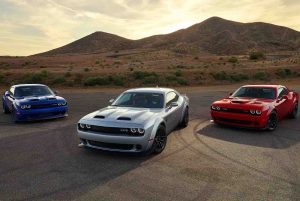
Naturally, the government favors the making of more of the latter by making the manufacturing – and selling – of the former more and more expensive, with the end goal being to make it so expensive than only a handful will be made – sold to the handful who can still afford to buy.
Which brings up another pertinent – and related – question:
Even with the subsidies at the manufacturing level and the pay-off to the buyer ($7,500 at the federal level plus state-level additional pay-offs, in some states) EVs are still much more expensive than not-electric equivalents.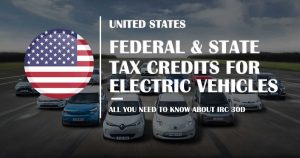
A Nissan Leaf with the standard 150 mile-range battery stickers for $31,670 ($38,270 for the model with an upgraded battery that increases its range to 227 miles, assuming you don’t drive especially fast or use electrically powered accessories like the AC and heat too much – both of which drain range by draining the battery). It goes about as far on a charge as the 797 horsepower Dodge Hellcat Charger I reviewed recently. The Dodge gets 12 MPG – but it can be refueled and ready to roll again in less than five minutes – as opposed to several hours.
A Chevy Bolt stickers for about the same as the Leaf – $31,995 – though it has a nominally greater range of 259 miles (about half as far as typical subcompact economy car can travel on a full tank).
A Tesla model 3 starts at $39,990; if you want one that can travel farther than 263 miles, the MSRP rises to $48,990.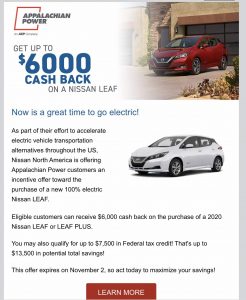
These are the most “affordable” electric cars on the market – and their actual cost is higher-than-advertised; they are sold at a net loss (the companies selling them write off the loss or make it up via the profits earned on the cars that do sell or – as in the case of Tesla – by selling carbon credits for making them) in order to make them appear less costly than they actually are – for now.
Until there is no alternative to them.
The non-electric analog of the Leaf is the Kicks, a compact crossover about the same overall size and with slightly more room inside for cargo (the available space not having been eaten up by batteries). It stickers for $21,326 and you don’t have to pay extra to be able to travel as far as 388.8 miles – more than twice as far as the standard-battery’d Leaf can go and 100-plus miles farther than the optional battery’d (and $40k, almost) Leaf can go.
The non-electric analog of the Chevy Bolt is the $21,400 Chevy Trax, which is about the same shape and slightly larger than the Bolt. It can also travel 434 miles on a full tank of gas, as opposed to 175 miles less far – for $10,595 more. Not counting the cost of the wait while the Bolt recharges.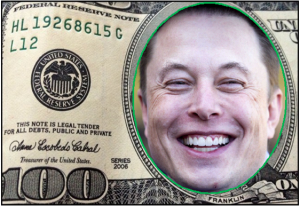
The Tesla 3 is a small sedan that’s comparable in dimensions and general layout/features to a Honda Civic sedan – which isn’t as quick to 60 as the Model 3 but can also go 434 miles before it has to stop for gas; that’s about 200 miles farther down the road than the Tesla can go before it has to stop – and wait – for a recharge. The Honda’s price – $21,050 – is $18,940 less than the price of the Tesla 3.
It’s interesting to observe that the price/range difference between the electric and their analogs is not far off the 40 percent mentioned by Uncle Joe – and that begs another question:
Will Americans be earning roughly 40 percent – or even 20 percent – more than they currently do come 2030, so as to be able to afford to buy 40 or even 20 percent more expensive electric cars?
If not, who will buy them? Even assuming 40 or 20 percent want to buy them?
These questions are begged but never asked by the derelict press, which is either incapable of asking pertinent questions – or paid to not ask them.
A final question also ought to be asked: Why is it necessary for the car companies to “pledge” to build any type of car, if there is market demand for it?
The answer, if course, is that there isn’t. And that’s why no one’s allowed to ask it.
. . .
Got a question about cars, Libertarian politics – or anything else? Click on the “ask Eric” link and send ’em in!
If you like what you’ve found here please consider supporting EPautos.
We depend on you to keep the wheels turning!
Our donate button is here.
If you prefer not to use PayPal, our mailing address is:
EPautos
721 Hummingbird Lane SE
Copper Hill, VA 24079
PS: Get an EPautos magnet or sticker or coaster in return for a $20 or more one-time donation or a $10 or more monthly recurring donation. (Please be sure to tell us you want a magnet or sticker or coaster – and also, provide an address, so we know where to mail the thing!)
My eBook about car buying (new and used) is also available for your favorite price – free! Click here. If that fails, email me at EPeters952@yahoo.com and I will send you a copy directly!











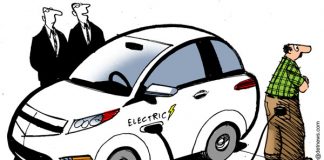
Advice from Tesla: “Consider allowing the battery to burn while protecting exposures.”
https://www.sfgate.com/news/article/While-they-were-asleep-their-Teslas-burned-in-16363177.php
if the govt can lock you down due to a bothersome virus, the precedent has been set for locking you down for anything they deem an “emergency”.
since the feds already claim the ability to regulate autos, including post-purchase, all they have to do is lockdown your ICE car.
I knew I should have been a garbageman. Those guys never got locked down. And when those guys go on strike, they always get what they want (and people still talk about it 50 years later).
I’ve been toying with the idea of running for govking in my state of NC on the explicit platform of declaring an emergency day one and ruling like a monarch via executive orders and “mandates.” I would represent “The emergency law party for voluntaryism.” Upon declaring an emergency day one, I would order all laws, regulations, taxes, and other governmental activities, except those prohibiting violence against person or property to be voluntary. According to the existing emergency law, should any governmental sub entity interposition against me, I would have them arrested. Apparently, according to current precedent, this can be done as long as I can convince a small group of legislators to support me by nullifying any veto overrides requiring a supermajority.
Maybe they’re giving “us” until 2030 because that’s how long it will take to get all the mile-delimited measurements converted over to kilometers. After all, 150 piddly miles per charge is a whopping 240 KM! Sounds like a whole bunch more right? And why would anyone want to travel at 70 MPH when the PSL is 100 KM/h? That’s like… geez, 30 more!
Now I know what you’re thinking… “My car gets 40 rods to the hogshead and always will!” OK Boomer! Remember how quickly everyone got used to buying soda by the liter? Hell, we’ve always bought weed by the gram, right? And then they’ll reprice gasoline by the liter too, think about how cheap it will be! Hey Gertrude! Pull over here, gas is only 92₵!
(Sarcasm, just in case there are any Californians in the room…)
> And then they’ll reprice gasoline by the liter too, think about how cheap it will be! Hey Gertrude! Pull over here, gas is only 92¢!
There were some gas stations that tried that once before, about 40 years ago. It went over about as you’d expect.
Well, many Southern Californians travel to Baja California, where gasoline has always been sold by the liter, and many Mexicans travel to, or move to, Alta California. So, there are plenty of people here who are comfortable with either system of measurement, and can do the math in their heads.
The real challenge, IMO, will be changing the posted speeds from MPH to KPH. I think they will have to have both numbers posted, at least for awhile, where “awhile” may be ten years.
Oh wait, you’re serious?
Let me laugh even harder.
‘Will Americans be earning roughly 40 percent more than they currently do come 2030?’ — EP
HA HA HA. That was a rhetorical question, folks!
The last time some fool thing like that happened was in the 1950s and 1960s — not only in Leave It To Beaver America, but even more so in stately old Europa, where the transition from postwar austerity to having all the mod cons (as they say in Blighty) was head-spinning.
Jean Fourastié’s Les Trente Glorieuses – styling France’s 1946-1975 years as a flat-out economic miracle — today evokes (depending on one’s age) either a yawn of nostalgia or (in under-30s) a stare of disbelief. Once Eurosclerosis got a clammy grip in 1980s, the advance of middle class living standards smacked the wall with a ghastly plop.
Another former miracle economy, Japan, reached its moonshot apogee on Dec 29, 1989 — the never again equaled all-time high of the Nikkei stock index. Now its population is shrinking faster than any country on earth, as its youth shun sex, reproduction, and the hell of other people. Hikikomori means the afflicted refuse to leave their parents’ house, do not work or go to school, and isolate themselves in their womblike room with a hot plate and cases of ramen noodles.
But somehow debt-choked, Demonrat-haunted America is supposed to ‘electrify’ its economy and its transport by 2030, in the fantastic delusion of anencephalic old Corn Pop?
Yeah, right … it’s more like twitching the leg of a dissected frog via muscular galvanism. 2030, butt hurty, pols play dirty. *reaches for his revolver*
Face it, we peaked in 1969 or so.
Forty years you waste
To chase the dollar sign
So you may die in Florida
At the pleasant age of sixty-nine
— Steppenwolf, The Ostrich
Always misheard that verse as, ‘In the pleasant days of ’69’ *wink*
Not to mention of course that at present California doesn’t have a power grid sufficient to support its demand for AIR CONDITIONING. 40% EVs will mean a lot of very expensive bricks sitting in driveways and garages. There is not even any mention of any effort to build a grid that would support such massive increase in EVs, which suggest that the 40% will not be achieved by a significant increase in EV sales, but a more than significant decrease in car sales in general, until current numbers of EVs sold will constitute that 40%.
MAAS. Mobility As A Service.
Even if you can afford the car … and the electricity … you won’t be able to afford the tolls required to pull the car out of the driveway if it isn’t “your” day to drive.
Tolling of surface streets is coming. The tech is already available — the same gear which will run tolling on the “Fredericksburg Express” express lane project in VA next year.
FaaS. Futility as a Service.
Vote; pay taxes; enable your own torment.
The taxes pay for the roads. The tolls will fund pensions in other countries.
@Eric – I’m surprised you haven’t picked up on this racket, promoted by the Coonman and his predecessor.
https://www.transurban.com/news/partnering-to-drive-growth
Hi Roscoe,
Yes, I’m hip – and expect something more about this, soon!
$2.1 billion dollars.
https://investableuniverse.com/2020/12/18/transurban-virginia-express-lanes-australia-canada-funds/
And if anyone thinks toll roads are only for cities and turnpikes, Singapore is starting to replace their extensive gantry-based tolls with satellite-based ones this year.
Singapore readies satellite road toll system for 2021 rollout
https://www.zdnet.com/article/singapore-readies-satellite-road-toll-system-for-2021-rollout/
40% production by 2030? Easy. Keep producing the same number of EVs currently produced and cull world population by +60%. Once the fuel hogs are fossils, they can cut ICE production down to exceed that 40% request.
Why couldn’t they put this much energy into flying cars? Oh wait those would be reserved for the beautiful people so they don’t have to mingle with we mere mortals.
How are off-road enthusiasts going to continue their activities when only EVs are available? Or do you only get to off-road for like, you know, a quarter of the range and then back to the city for a recharge? Or are they planning on installing 480v “quick” chargers in the wilderness?
I was wondering about this after having seen one of the most ridiculous looking Jeep models in the history of mankind recently. That white “X” on the tail lights… who in hell thought that was a good idea? In fact, that is what caught my eye and the more I looked at it, the more my eyes were assaulted by the hideousness of the damn thing. But I digress.
Say “goodbye” to off-roading, I think is where we’re headed then, isn’t it?
Same thing with racing. How long will it be before some nimrod at the EPAFDADOTNHTSADOJBLMNFSFBICIANSA thinks that recreational use of “fossil” fuels needs to be banned to save Earth Mother Gaia?
You mean, outlaw the manufacture and sale of nitromethane?
Calling Walter White. Forget meth, Walter. Make us some nitro.
How about, we just ban “recreational motorsports?”
No one “needs ” to go racing.
HAH HAH HAH HAH HAH.
When dragstrips are outlawed, city streets will be dragstrips.
Oh, wait. They always have been.
Hi Eure,
I was going to write an addendum rant along the lines of your post. I live roughly 220 miles from the press fleet for my region. Most of the EVs available cannot make the trip without stopping for a lengthy recharge and those that can make it will require I wait for at least half a day before I can drive the damned things because I do not have a “fast” charger at my house and that means a minimum of 4-6 hours to instill a partial charge.
I doubt I will be getting many EVs to test drive. The last one I got had to be sent (and picked up) on a flatbed.
The environuts get pissy when you have the gall to walk off trail. Destroying the ecosystem and all yaknow. Leave no trace or else! The inability to access the woods or even rural areas outside the urban panopticon is a feature of EVs that really gets the greens jowls frothy. Picture panem as our future. Only public transit for long hauls, people penned in approved settlements and green spaces fenced off. You can already see it anywhere theres a public green space. Zones are fenced and signage erected to keep you out to save the sea oats or sumsuch.
Well, if you start to hang out on the land you might mess it up and ruin the (literally) million dollar view. There goes the neighborhood! “Backs up to public land” is a major selling point for investment property, and not because there’s an implied easement for access. If no one can develop land no one can afford it either.
They need to meet up with someone who truly leaves no trace…
“2030: You will own nothing and be happy.”
This is just part of the Transportation As A Service model that is being built. 60% of vehicles sold will be truly “autonomous” and sold to GovCo. The other 40% will be TAAS, 5G Automated and tethered and “sold” (leased at best) to the TAAS companies. It’s all part of The Great Reset/4th Industrial Revolution/Brave New World Order that is being jammed down our throats and up our butts.
With the Cyber Polygon exercise in the rearview mirror, how long will it be before the Internet of Things comes to a grinding halt?
https://sociable.co/government-and-policy/cyber-polygon-great-reset-centralized-power-surveillance/
Whether it’s Klaus Schwab and his band of merry pranksters or someone even more nefarious pulling the plug, it’s going to be a bumpy ride. The good news is it will all collapse under the weight of its own contradictions.
The best we can hope for is once the mass extinction of the vaxxed is complete, maybe we can rebuild with a remnant that sees GovCo as the enemy. Never again allowing that putrid institution to rise from the swamp of evil.
As the big guys implode, they will leave room for others to come in and do a better job. Also, hopefully, it will turn into an opportunity to clear out a lot of the regulatory dead wood.
I fear the usurpers will just be President Coin replacing President Snow.
Those who wish to rue, even a market, wish to rule first and foremost.
We need to tell EVERYONE No. And we must have the tools to do so, as well.